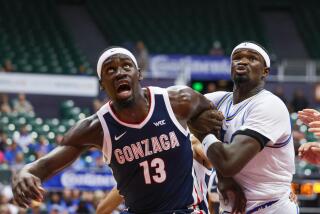No Charge For Making Free Shots
- Share via
In the final moments of the game, with nothing more significant than a national championship at stake, Kbalid El-Amin stepped to the foul line for Connecticut.
He had been there hundreds maybe thousands, of times before in school yards, in gyms, anywhere there was a hoop hanging off a backboard. He had been one of UConn’s best free throw shooters all season, making almost 79 percent of the shots. Only six times all season had he missed two foul shots in a game.
And yet, earlier that night, the fire plug of a point guard confidently stepped to the line, eyed the basket, set himself and ...
Clank!
Clank!
It happens all the time to players who take foul shots matter-of-factly, which hardly describes El-Amin. Too often though, they prefer to refine their highlight package, 360-degree, in-your-face, reverse slam dunks.
The fact is that one shot at a time, points from the line do add up. El-Amin’s two early bricks were lost opportunities that cost the Huskies a couple of points in a game in which every one of them would be vital.
So with five seconds left in the game, after being fouled by Duke’s William Avery, El-Amin returned to the foul line for two more shots, two more chances to make a difference. He was in such a big hurry to get there he practically ran.
“I wanted to redeem myself from missing the two earlier free throws,” he said. “I wanted to be the one.”
He never thought about the misses. He simply stepped up to the line, followed the same routine he had his whole life, the one that had failed him before. This time, he cooly drained the foul shots, the final points in UConn’s 77-74 victory.
Nothing to it.
Well, in fact there’s plenty to it. Otherwise, everybody could do it. There were some dreadful attempts at the Final Four.
Duke missed 13 of 27 foul shots in the semifinal against Michigan State but did not get hurt because the Spartans cooperated by missing five of their own. Then Duke blew six more free throws in a championship game that it lost by three points.
UConn alum Ray Allen is the leading practitioner of the art of the foul shot in the NBA, where players make 72 percent of their attempts. He is connecting at 93 percent. Darrell Armstrong of Orlando and Reggie Miller of Indiana are next, both at 91 percent.
Then there is the other end of the chart.
Vin Baker of Seattle is at the bottom, managing just 41 percent. By chance, he ought to do better than that. The shots, after all, come with no charge. They are, remember, free.
Chris Webber of Sacramento is having a bang-up year but not at the foul line, where he’s at 47 percent. Then comes Antoine Walker of Boston at 49 percent, Antawn Jamison of Golden State at 50 percent, and completing the bottom five, Shaquille O’Neal of the Los Angeles Lakers, one of the 50 greatest players in NBA history, in at 54 percent.
Each of the bottom five is a big man and Syracuse coach Jim Boeheim has a theory about that.
“Usually, big guys are not good foul shooters,” he said. “They score from inside, around the basket. Even with 3-pointers, outside shooting is down. If you’re a 33-percent 3-point shooter, that’s good. If you’re a 33-percent free throw shooter, that’s bad.”
Boeheim believes that shooting generally is down and the free throw problems are a consequence of that.
Years ago, Boeheim’s teams were going through a tough stretch shooting foul shots, sometimes paying dearly for the misses.
“We had a big, strong, physical team, guys like Rony Seikaly and Derrick Coleman,” he said. “Because we were so physical around the basket, we shot twice as many free throws as anybody else. We made more free throws than some teams took.”
Eventually, the frustration of all those missed foul shots caused Boeheim to import some help. He hired a professional free throw guru to work with his team on concentration, technique, follow through, all the elements of foul line success.
And what was the result?
“Our percentage went down.” he said.


